Searching for Health Info, Products and Hope on the Internet in the Time of COVID-19
An analysis of consumer online health activities reveals a great deal about the mood of Americans at the onset of the coronavirus pandemic

Introduction
What did we search for online in regards to health info, medicine, treatment options and yes, products that may - or may not - really help us in the midst of the COVID-19/coronavirus pandemic? In short, Americans - scared, quarantined, and with plenty of time on their hands - used the Internet a whole lot (in the best academic term this expert can muster) while they began to face life in isolation and lockdown in the face of this epidemiological Black Swan event!
In a prior article ("What We Want Online During the Pandemic, And What That Says About Us"), this analyst examined general Web trends during the month of March 2020 - the month when the coronavirus unfortunately became the story of most of our lifetimes and a monumental challenge for the entire country. In this article, we will look specifically at the health aspects of our online lives during this tumultuous period. And yes, this analysis will reveal a great deal about what you, I, and our neighbors were worried about, thinking about, and searching out as our country and ourselves came to grips with the worst pandemic in over a century.

GLIMPSE-ING THE PUBLIC
Recently, I became acquainted with the work of New York City-based Glimpse, which seeks to aggregate info from all of our activity across all of our online activity to discover underlying trends regarding products, companies, and industries. Glimpse’s key metric is what they term to be consumer interest levels, which is based on the company’s proprietary analysis of “hundreds of millions of consumer behavior signals from across the web.”
And so in looking at Glimpse’s statistical analysis of consumer interest levels in various products during last month (March 2020), the month when the COVID-19/coronavirus pandemic took off in the United States and brought-on both self- and state-imposed stay-at-home orders and quarantines, all of this reveals some very interesting insights into the mind and mood of Americans as we collectively encounter the fear, uncertainty, and economic disruption that has resulted from the widespread outbreak of this deadly disease and our efforts to isolate ourselves to “flatten the curve.”
In this research, we looked specifically at Glimpse’s data on consumer interest levels across a variety of health topics in March 2020. And as a reminder, as the disease outbreak worsened in mid-March in many areas of the country, most states implemented their stay-at-home orders sometime between the March 20th-April 1st period. Each chart below thus represents consumer interest levels data in that specific health subject for the entire month of March 2020. And as you look at these trends, do bear in mind that with the timing of the pandemic, the trends in the latter half of the month reflect the very real changes in consumer interest levels in these products/services among Americans as the pandemic caused people to shelter-in-place.
Here then are some of the more interesting health trends spotted in Glimpse’s look at where America is - at least from a consumer perspective - in this most unsettled of times. We break down our analysis into two sections, examining the demonstrated consumer interest levels of Americans in March 2020 regarding first things that definitely help in the fight against the disease and then things that were largely "pandemic fad items" - rumored (or worse) to help prevent or even cure the coronavirus! This includes both items ranging from laundry items to homemedical equipment and then a whole range of supplements and pharmaceuticals (largely for off-label usage as a potential COVID-19 prevention/remedy) that saw interest from a very scared American public during the early stages of this pandemic in March 2020.
Trends for Things That Definitely Help...
Telemedicine
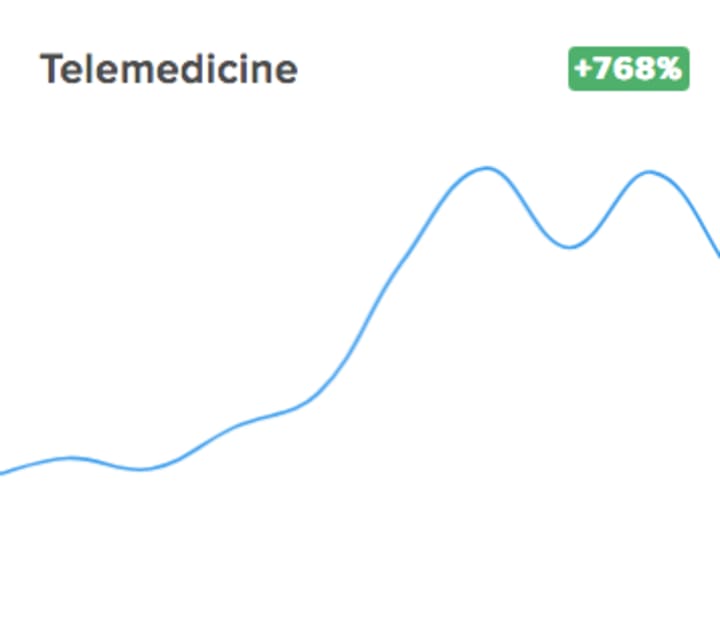
Why Is This Trending? Telemedicine had been on the rise before March 2020. However, with patients fearing being exposed to the coronavirus and doctors/clinics wanted to prevent infection of their patients and their staff, the pandemic seems to have created intense interest in all forms of telemedicine and telehealth.
According to the Centers for Medicare & Medicaid Services (CMS), these terms, along with variants that may be employed by health plans, hospitals, etc., refer to any practice that results in "the exchange of medical information from one site to another through electronic communication to improve a patient’s health." Also, many hospitals and clinics have been directing patients who might believe they are experiencing mild to even moderate COVID-19 systems to use their telemedicine options rather than trying to visit their facilities. This has been facilitated by states and health insurance plans changing rules and regulations regarding both patient access to telemedicine and physician/facility reimbursement provisions to encourage greater use of online interactions. And likely, these changes will likely greatly accelerate the growing acceptance by patients, providers, and payers of telemedicine to reduce actual in-person patient care long beyond the immediate coronavirus outbreak.
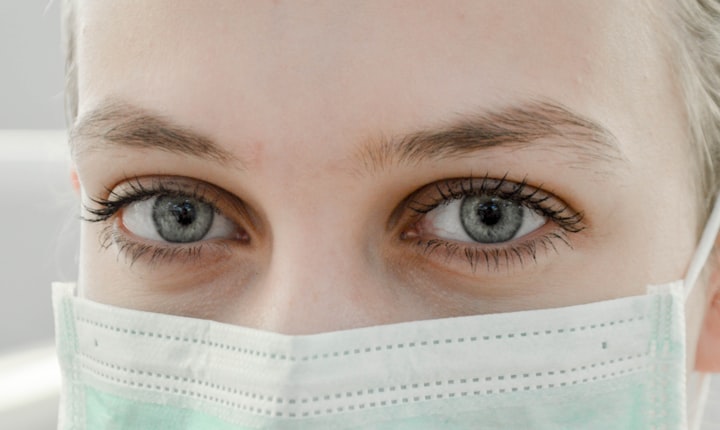
Personal Protective Equipment
One very unlikely trend that became readily apparent in examining Glimpse's March 2020 consumer interest level data was that undoubtedly, many, many individuals, hospitals, clinics, governments and companies were obviously looking all over the Web for the PPE (personal protective equipment) that quickly came to be in short supply in many areas of the country, endangering both medical care and medical workers.
While the lack of PPE became a leading subject of intense media coverage and political debate as the COVID-19 outbreak worsened, for those working in hospitals and for first responders, PPE became a matter of life and death for those employed in the health care sector. As such, when their employers and institutions could not provide the items they needed, many doctors, nurses and other medical workers turned to the Internet for information and for acquiring their own PPE through many peer-to-peer and charitable networks that began to pitch in to help them. Additionally, some Americans bought PPE items for their own personal use in an attempt to protect themselves from coronavirus exposure - maybe beyond what they could have and should have for any home, work and/or social use outside the health care setting - no matter the circumstances. .
The Glimpse data definitely shows intense consumer interest levels in PPE in March 2020 in regards to both isolation gowns (up 1154%) and Tyvek suits (up 400%). And yes, the consumer interest level in masks of all types and protective levels in the upcoming month of April should be - well, incredible - given the intense shortages of the different levels of protective masks/shields and the recent call for Americans to begin wearing masks in public places!
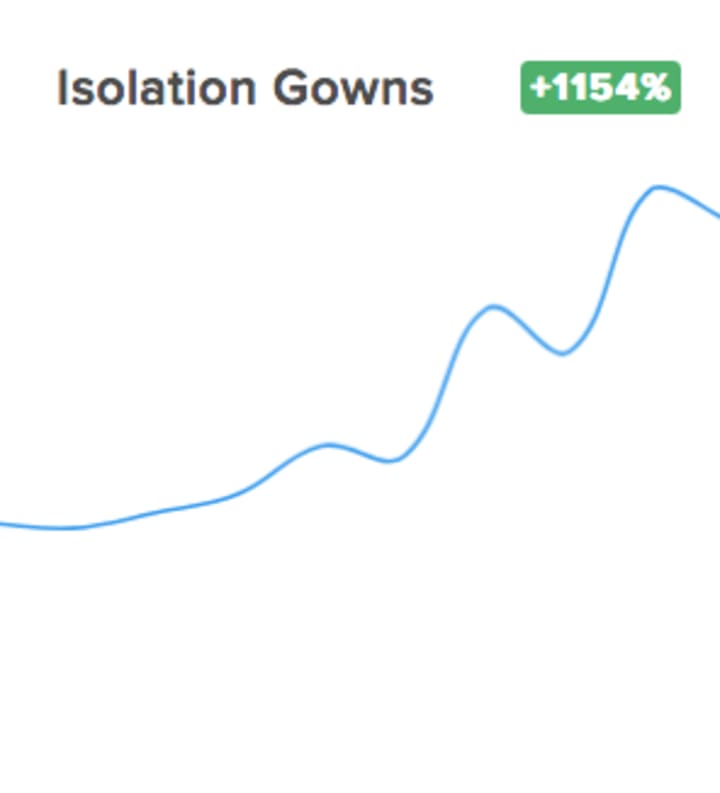
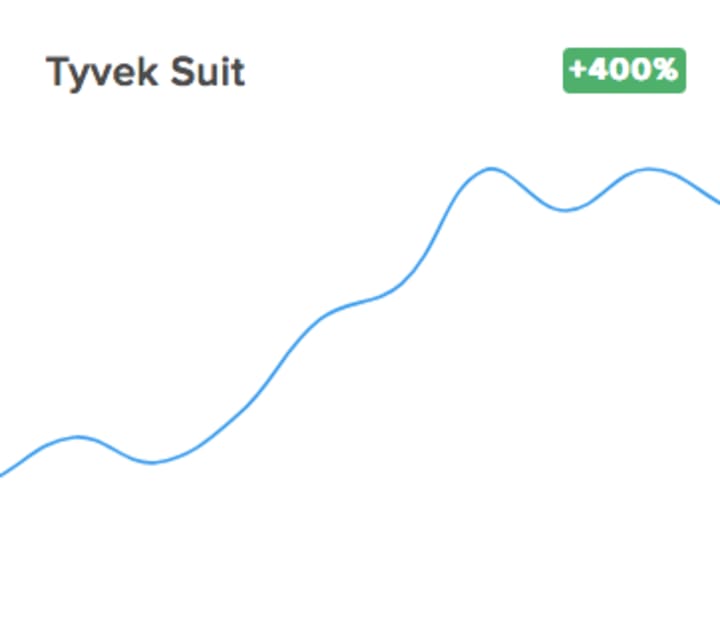
Around the House Items
Glimpse's look at consumer interest levels in March 2020 shows that in the early stages of the pandemic, there was intense interest among Americans - seen in their online activities - in taking steps that could help protect themselves and their family from the coronavirus. We all know about the craziness all across the country that surrounded hand sanitizers - a topic that Glimpse did not include in their COVID-19 review that this researcher hopes will be in their next release of monthly data on April 2020 consumer interest levels, as that should be literally off the charts! And so we Americans demonstrated intense online and offline interest in things that could possibly help in fighting the disease spread and in their potential infection with the virus.
Let's first take a look at alcohol prep pads - something that actually does work in helping prevent the spread of the virus. Because 60% alcohol solutions can kill the coronavirus, alcohol prep pads - the same kind of wipe that health care workers use to clean your arm before giving you a shot or drawing blood, since the prep pads have 70% alcohol solutions on them, they became popular to stock-up on to help prevent the spread of the virus. Just as with the mad rush for hand sanitizers, consumer interest here was in products that actually did prove to have value in helping prevent the spread of the coronavirus. And so yes, both then and now in April 2020, this sleepy product category suddenly became a must have for many Americans.

There are, of course, a variety of other household items that can be utilized in the fight against the spread of the disease. This led to panic buying of everything from soaps to various disinfecting cleansers and yes - hand sanitizers. One of the areas reviewed in the Glimpse data is laundry sanitizing, specifically how to kill the virus in the washing process. As you can see in the graphic below, consumer interest levels in laundry sanitizers rose by a whopping 1153% in the month of March 2020.

Now the science of just how long the coronavirus can exist on various fabrics and how best to actually "do" laundry to most effectively "kill" the virus is quite complex (see an excellent article on the subject for specific guidance on this matter: "How Long Coronavirus Lives On Clothes, And How To Wash Them"). And so yes, Americans showed a dramatic increase - well over tenfold - in their interest online in learning about laundry sanitizers and how to make use of them - hopefully properly - to fight the spread of the virus!
...And Trends for Things That Don't Really Help (and Maybe Hurt!)
One thing that we know about the Internet is that for all the value that it has as an information source, the counterargument is that the Web is fraught with not just disinformation, but plainly dangerous information! And that has certainly been the case in this instance, as not just Americans, but people around the globe have looked to online sources for answers to the dangers of the COVID-19 pandemic.
Want Exhibit A of misinformation on the coronavirus on the Internet? Let's start by looking at colloidal silver - a water solution in which small particles of silver are suspended - has long been used as a sterilization agent to be used only topically. Early in the coronavirus outbreak in the United States, televangelist Jim Bakker and others touted oral colloidal silver solutions as a way to prevent COVID-19, only to be cracked down on by the FDA (Food and Drug Administration). However, as the graph shows, this action did not entirely stop interest in ingesting colloidal silver as a means of preventing the coronavirus, even though the NIH (National Institutes of Health) issuing a warning that:
- Colloidal silver can cause serious side effects. The most common is argyria, a bluish-gray discoloration of the skin, which is usually permanent.
- Colloidal silver can also cause poor absorption of some drugs, such as certain antibiotics and thyroxine (used to treat thyroid deficiency).
- The FDA also warned in 1999 that colloidal silver isn’t safe or effective for treating any disease or condition.
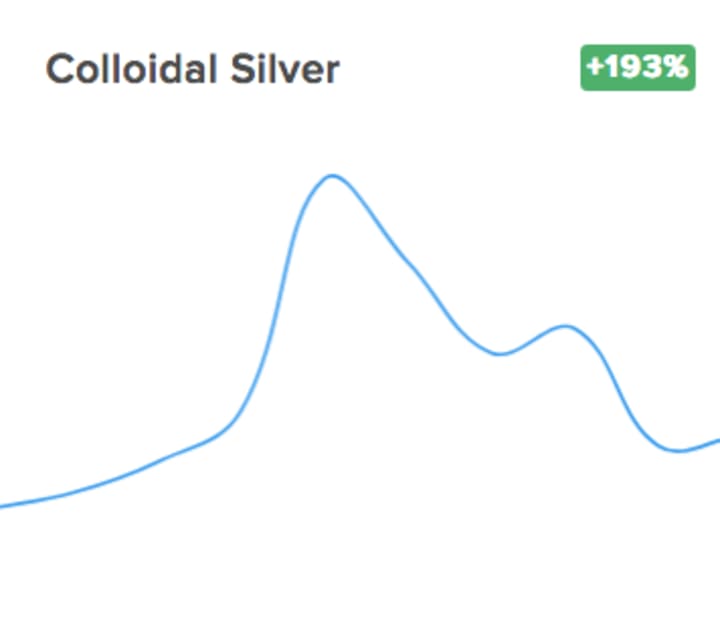
Now on the flip side, Americans also searched for a variety of items that may pose no harm to them, but might also have no real proven benefit in either preventing or fighting the coronavirus. Two such trends were revealed in the present analysis of the Glimpse data from March 2020. First, consumer interest levels in oximeters, a common portable home medical diagnostic device that measures oxygen saturation in the bloodstream, rose by over 200% in the early stages of the COVID-19 pandemic.

The increased consumer interest in these devices, mostly used by individuals with chronic respiratory conditions to monitor if their oxygen levels would be below normal, was attributed to media reports, including TV host Andy Cohen, who said that he used a pulse oximeter himself as he fought his own COVID-19 infection.
However, medical professionals warned in the media that for most people, these machines, while not causing harm, were ineffective in detecting possible COVID-19 infection.
Likewise, during March 2020, consumer interest levels in ozone generating machines, commonly employed to remove strong odors from homes, office and other spaces, jumped by 224%! Again, the rush to find information on

ozone generators during the early days of the coronavirus in the U.S. was driven by both reporting and rumors on how these machines could be employed to fight against - and perhaps even kill - the virus. While ozone sterilization is a proven means used by hospitals to sterilize equipment and have worked on some types of coronaviruses in the past, including the virus that caused SARS during the 2003 epidemic, when used improperly, these devices can also "create a wide range of health problems, particularly with the lungs. They can inflame and damage airways and make the lungs more susceptible to infection." The Internet "word of mouth" on ozone generating machines got so bad that the EPA (Environmental Protection Agency) recently had to come out and publicly advise Americans not to use ozone generators as a preventative device for dealing with the coronavirus, as the risks far outweigh any possible rewards!
Supplements and Drugs
During the early part of the COVID-19 pandemic in the United States, there was intense interest in existing supplements and even prescription drugs that might prove helpful in preventing against and/or treating the coronavirus. Even the President of the United States got in on the action here, helping fuel intense consumer interest levels in Hydroxychloroquine, a long-standing antimalarial drug that quite controversially may have some use in treating COVID-19 infection.
And while the political, medical, and scientific debate rages on over the efficacy of Hydroxychloroquine's potential use in treating the coronavirus, the media attention has only served to fuel Americans curiosity in the drug. This is evidenced by the fact that online activity for Hydroxychloroquine jumped well over 7000% in March 2020!

While consumer interest levels spiked in common supplements such as:
- Vitamin C Gummies
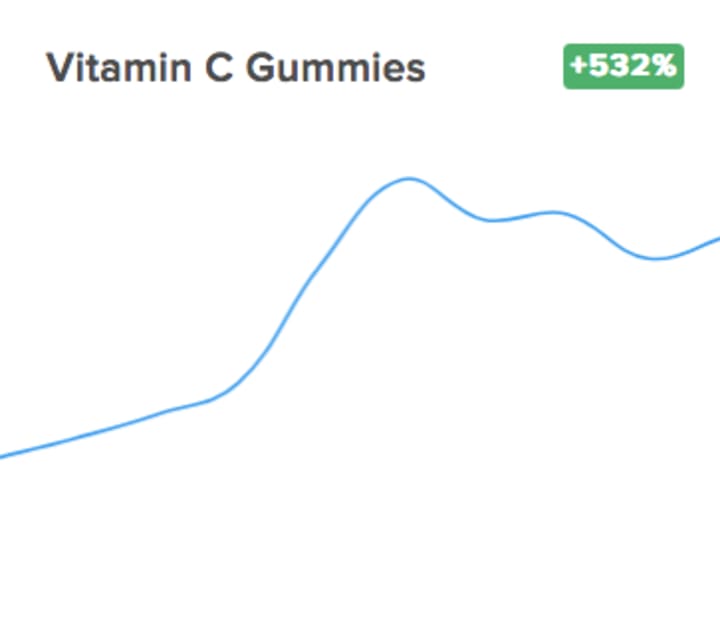
- Zinc Lozenges
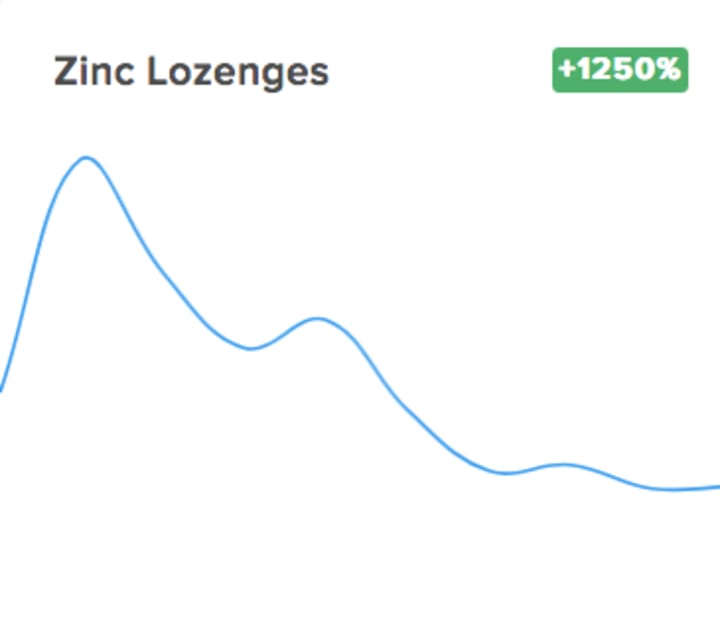
- Oregano Oil

... so to did public interest in a whole host of prescription drugs, which, like Hydroxychloroquine, were being touted by some reputable and some not so reputable sources in the media and especially online as possible "cures" for the coronavirus. These were largely for drugs to be used in so-called "off-label use" (which means using an FDA-approved drug for an unapproved use), as well as pharmaceuticals that might not even have been granted approval for use in the United States, including drugs such as:
- Arbidol (up over 13,000%!)
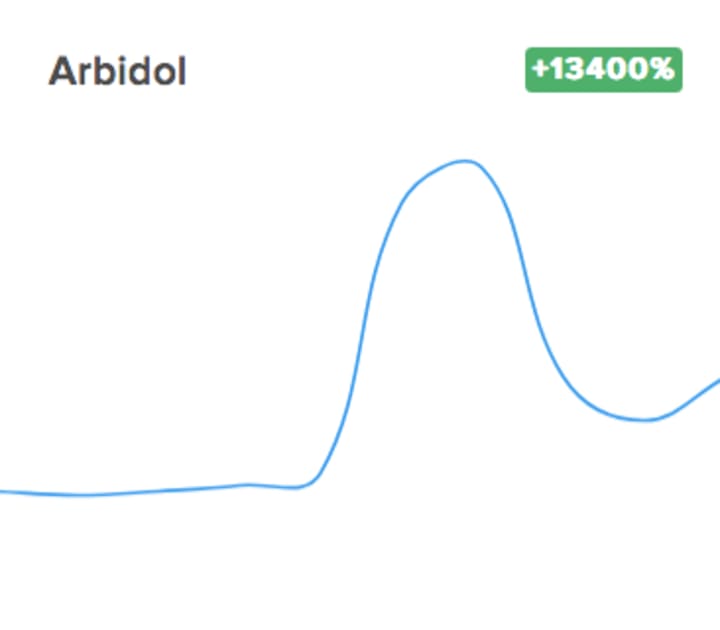
- Aplidin
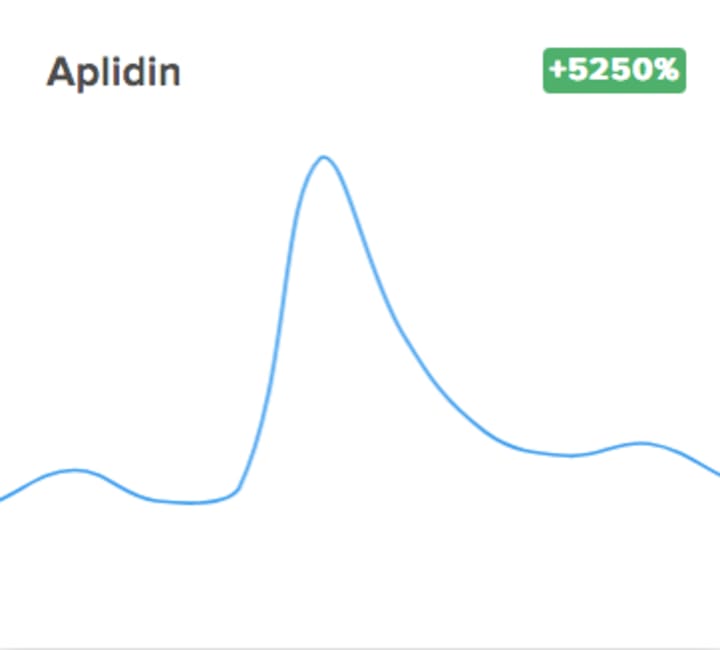
- Tocilizumab
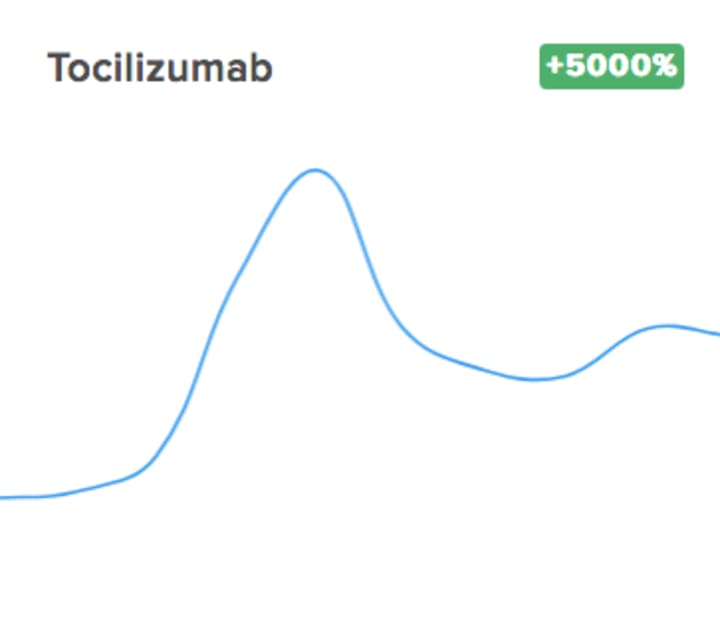
- Umifenovir

- Plaquenil
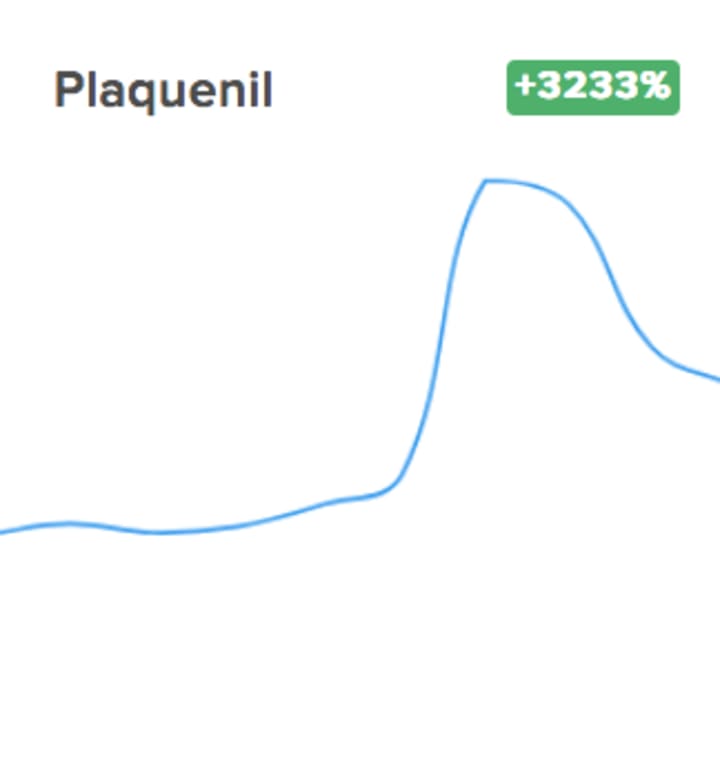
- Kaletra

- Lopinavir

The issues involving the use of prescription drugs off-label and even pharmaceuticals that have not received FDA approval against the coronavirus is a complex subject, one deserving attention far, far beyond what this author can - or should - provide. As the President of the American Medical Association, Dr. Patrice Harris, recently warned: "This is a new virus, and so we should not be promoting any medication or drug for any disease that has not been proven and approved by the FDA.”
One thing is certain however: The consumer interest level in grasping for anything that might help prevent coronavirus infection or work for COVID-19 patients is something that the media, public officials, and yes, pharmaceutical companies should continuously monitor and be in a position to "rapid react" to as trends in online activities develop. "Things" seen on social media, heard in real life, and viewed in online and/or traditional media can quickly form into a vicious, and even dangerous circle and put lives at risk. Therefore, this is an area of Web activity that needs to be closely and continuously monitored. While the monthly data examined here is interesting in terms of looking at macro level movements of American consumer interest levels at this time in retrospect, real-time analysis of such trends will be especially critical for companies and governments to protect public health from misinformation on pharmacological treatment options and availability during the pandemic.
CONCLUSION
In a time of great uncertainty, from almost every perspective - health, economic, social, familial, etc. - we know that all of us will likely make use of the Internet more than ever before. We will be online - from home for the most part - working, watching, communicating, and yes, searching for medical information online and answers to the questions that all of us have in this unsettled time.
And so while this article is a single-shot analysis of one month of data detailing Americans’ consumer interest levels at this very unique and unprecedented period of history, this is just the beginning of what will be a very interesting stream of research on how we - both collectively and individually - interact online in an era of profound crisis. As a management professor and “expert” on such marketing and strategic matters, I believe that we will learn a great deal from analyzing how not just Americans, but individuals around the world used the luxury of “having the world at our fingertips” during the coronavirus pandemic of 2020. And maybe, just maybe, we can learn lessons on how to do things better in terms of corporate, governmental and individual/familial reactions in a time of collective crisis. I for one believe that there is a great deal of insight to be gained from all of this, and I personally look forward to more work on how we can “anticipate the unanticipatable” and do better the next time - or better yet, help to prevent that next time from ever happening!
_________________________________
David C. Wyld ([email protected]) is a Professor of Management at Southeastern Louisiana University outside New Orleans. He is a noted business consultant and speaker/writer on contemporary management issues.
About the Creator
David Wyld
Professor, Consultant, Doer. Founder/Publisher of The IDEA Publishing (http://www.theideapublishing.com/) & Modern Business Press (http://www.modernbusinesspress.com)






Comments
There are no comments for this story
Be the first to respond and start the conversation.